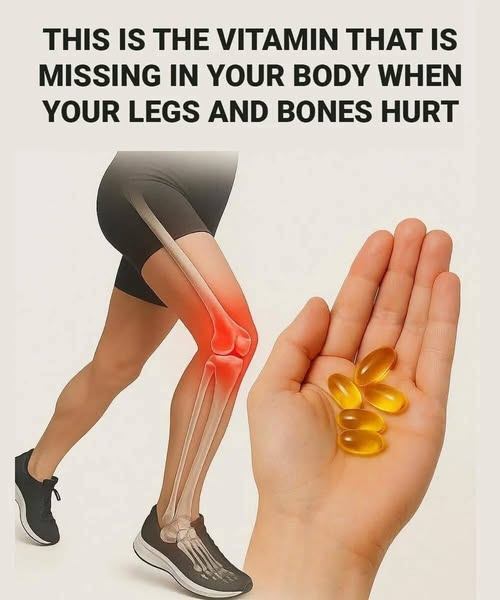
Your Body Might Be Whispering a Warning: Don’t Ignore These Subtle Signs
Have you ever found yourself experiencing unexplained leg pain, sudden nighttime cramps, or even feelings of bone weakness—without any clear reason why? You’re not alone. Many people brush off these discomforts as part of aging, stress, or just a bad night’s sleep. But sometimes, these seemingly minor symptoms are actually your body’s way of waving a red flag, pointing toward something deeper: a hidden deficiency in essential nutrients.
Listen When Your Body Speaks
Your body has an incredible way of communicating its needs. That nagging ache in your legs, the stiffness in your joints, or the occasional sharp cramp at night might not be random at all. These discomforts can be subtle clues that something is missing—specifically, vital vitamins and minerals that support your bones and muscles on a daily basis.
Often, these symptoms begin quietly and build over time. By the time you truly take notice, a nutritional imbalance may have already taken hold. That’s why paying attention to these early signs is so important—because the sooner you act, the easier it is to correct the problem.
The Importance of Vitamin D: More Than Just the “Sunshine Vitamin”
Vitamin D is well-known for its role in bone health, but its impact goes much deeper. This fat-soluble vitamin is crucial for calcium absorption—without it, your body can’t effectively use the calcium you consume. The result? Brittle bones, increased fracture risk, and even early-onset osteoporosis in some cases.
Low levels of Vitamin D can also lead to chronic muscle pain, weakness, and spasms—especially in the legs and back. One common sign of deficiency is experiencing muscle cramps or a dull ache that just won’t go away. Over time, even normal activities like walking or climbing stairs can become tiring or painful.
Who Is Most at Risk?
Vitamin D deficiency is far more common than many realize, affecting millions of people worldwide. Certain groups are more vulnerable, including:
- People with limited sun exposure: If you spend most of your time indoors, use high-SPF sunscreen constantly, or live in areas with long winters or low sunlight, your body might not be making enough Vitamin D on its own.
- Older adults: As we age, the skin becomes less efficient at synthesizing Vitamin D from sunlight, and kidneys may not convert it as effectively.
- People with darker skin: Higher melanin levels can reduce the skin’s ability to produce Vitamin D from sunlight.
- Those with restrictive diets: Vegan or dairy-free diets, or poor dietary variety, can limit intake of both Vitamin D and the minerals it works with—like calcium and magnesium.
Because the symptoms can develop slowly, many people don’t realize they’re deficient until the pain becomes more frequent or a fracture occurs.
Magnesium and Calcium: Quiet Powerhouses of the Body
While Vitamin D often takes center stage, magnesium and calcium are equally important in maintaining strong bones and smooth muscle function.
- Calcium is the primary mineral in bones and teeth. Without enough of it, bones become porous and fragile. But for calcium to be absorbed and utilized properly, it needs the help of Vitamin D—and magnesium.
- Magnesium plays a crucial role in muscle relaxation and nerve function. A deficiency in magnesium is a common cause of muscle twitches, cramps, restlessness, and even heart palpitations.
When all three nutrients—Vitamin D, calcium, and magnesium—are out of balance, the effects are compounded. Bones weaken, muscles ache, and the body’s electrical systems (which rely on mineral balance) begin to struggle.
Simple, Practical Fixes You Can Start Today
The good news is that many of these deficiencies can be corrected or prevented with a few thoughtful changes to your daily routine:
- Get Sunlight (safely): Just 10–30 minutes of midday sun exposure a few times a week can help your body produce its own Vitamin D. Of course, this depends on your skin tone, location, and the time of year.
- Incorporate Vitamin D-rich foods: These include fatty fish like salmon and mackerel, egg yolks, fortified milk, orange juice, and cereals.
- Add magnesium and calcium sources: Leafy greens (like spinach and kale), nuts, seeds, legumes, dairy products, and whole grains are all excellent sources.
- Consider supplements: If you’re at risk or already experiencing symptoms, a doctor may recommend taking supplements to restore your levels. Always choose high-quality products and consult your healthcare provider before starting a new supplement routine.
When to Seek Medical Advice
If you’re consistently experiencing leg cramps, bone discomfort, fatigue, or unexplained muscle pain—especially at night—it’s time to talk to a doctor. A simple blood test can check your Vitamin D, calcium, and magnesium levels. Addressing the problem early can help prevent complications like fractures, osteoporosis, or long-term muscular issues.
Even if the pain seems mild, don’t ignore it. Your body is trying to tell you something important.
A Final Reminder: Your Body Knows What It Needs
We live in a fast-paced world where it’s easy to dismiss minor discomfort as stress, aging, or “just a bad day.” But sometimes, these signals are the first signs of a deeper issue. Nutritional imbalances often go unnoticed until they become harder to fix. The more attuned you are to your body’s messages, the better you can care for it.
So the next time you feel that unexplained leg ache or wake up with cramps in your calves, don’t just shrug it off. Pause. Listen. Investigate. Because your body is speaking—and what it’s saying matters.



